Natural Strategies for Duckweed Removal in Aquatic Spaces
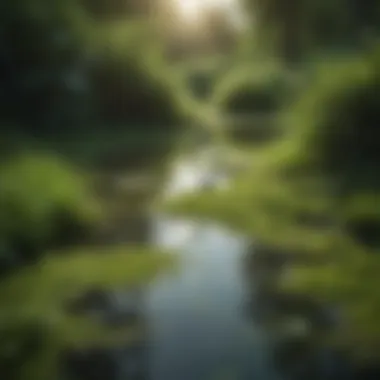
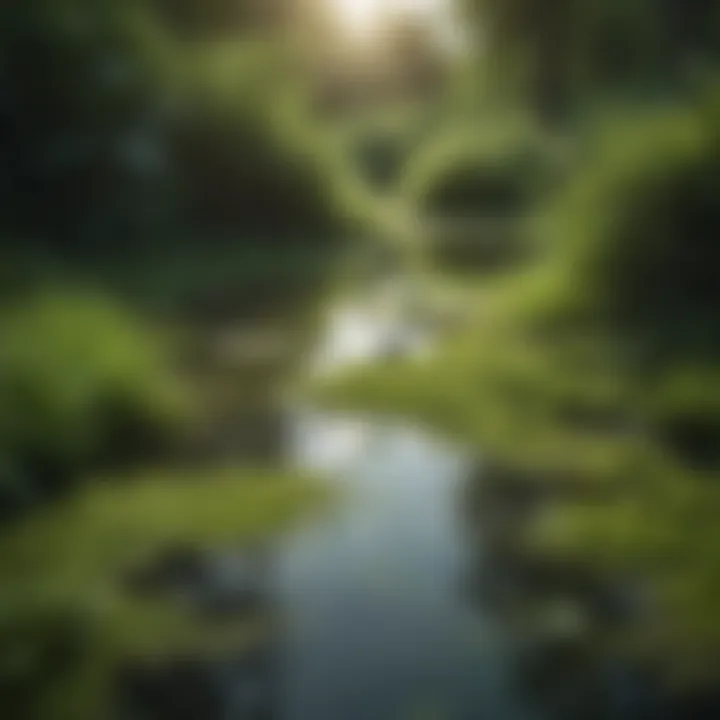
Overview of the Topic
Duckweed, a small floating aquatic plant, has become a thorn in the side for many pond and lake enthusiasts. These tiny plants, often no bigger than a dime, can rapidly cover the surface of water bodies, blocking sunlight and depleting oxygen levels, which can severely affect fish and other aquatic organisms. Understanding how duckweed grows and spreads is key to addressing its overabundance. It’s not just a nuisance; the consequences of unchecked duckweed proliferation can resonate throughout entire ecosystems.
Preface to the Key Natural Resource Issue
The plant thrives in warm, nutrient-rich waters—often habitats that support a diverse range of life. While some duckweed can serve as an essential food source and habitat for numerous organisms, its unchecked growth can lead to ecological imbalance. The excessive presence of duckweed can cause physical and biological stress to these water environments, leading to significant shifts in species populations.
Background Information on the Significance of the Topic
Duckweed can reproduce at alarming rates, and that’s where the trouble begins. When conditions are right—with plenty of sunlight and nutrients—it can multiply and dominate water bodies within days. For property owners and managers, this invasion disrupts recreational activities, such as fishing or swimming, and brings along economic drawbacks. Moreover, the excessive coverage can harm aesthetic values of waterways, reflecting poorly on conservation efforts and community standards.
Current Status and Challenges
Today, duckweed is commonly regarded as an invasive species across various regions. Its ability to thrive in man-made lakes and neglected ponds creates a pressing challenge for conservationists, ecologists, and those engaged in aquatic resource management.
Examination of the Current State of Duckweed
At present, duckweed populations are on the rise, particularly in nutrient-laden waters enriched by runoff from agriculture and urban areas. This trend shows no signs of abating unless proactive measures are taken. Its presence can lead to a downward spiral of aquatic health, where plants and animals struggle to survive.
Identification of Challenges and Threats Facing Ecosystems
Managing an influx of duckweed involves multiple layers of complexity. Chemical treatments, while effective, raise concerns about long-term environmental impacts. On the other hand, physical removal can be labor-intensive and costly. Thus, finding sustainable strategies becomes imperative—not just for the immediate control of duckweed, but for preserving the integrity of aquatic ecosystems overall.
Sustainable Solutions
Over the years, various natural approaches have emerged that can help in managing, if not eradicating, duckweed. These solutions range from biological controls to preventive measures and involve community engagement and local practices.
Exploration of Sustainable Practices
- Biological Control: Introducing specific herbivorous fish species, like grass carp, can significantly reduce duckweed populations by feeding on them. Not only does this offer a natural means of control, but it also enriches the ecosystem by adding diverse species.
- Water Management: Maintaining balanced nutrient levels in ponds and lakes can prevent duckweed from thriving. Regular monitoring and management practices can keep a check on nutrient input.
- Mechanical Removal: While laborious, manual removal can be a sustainable choice when done properly. Utilizing nets or rakes during cooler parts of the day when duckweed is easier to manage can keep the plant from spreading.
Showcasing Successful Case Studies
In several community-led initiatives, it’s been observed that combining water aeration techniques with biological control has led to a decrease in duckweed populations. These examples indicate that with the right mix of strategies, it's possible to effectively manage duckweed without compromising ecological integrity.
Impact and Importance
The ramifications of managing duckweed extend beyond mere aesthetics or leisure activities. Healthier aquatic environments foster fish populations that support both local economies and biodiversity.
Analysis of the Impact on Ecosystems
Ecosystem health hinges on the balance of flora and fauna. Duckweed overgrowth disrupts this balance, causing reduced oxygen levels that can lead to fish kills and loss of biodiversity. Taking steps to manage duckweed can renew aquatic habitats and restore essential ecological functions.
Emphasis on Conservation Efforts
The pressing issue of duckweed highlights the broader importance of conservation. By embracing sustainable methods, we not only address the immediate challenges posed by duckweed but also work towards fostering healthier ecosystems for future generations.
"The path to sustainability involves weaving together ecological understanding with community action. Duckweed management is a small yet significant step in this journey."
Understanding Duckweed
Understanding duckweed is crucial for anyone involved in the management of aquatic ecosystems. This tiny floating plant can have significant impacts on environments such as ponds, lakes, and wetlands. By grasping its characteristics and behavior, one can better implement effective control strategies. The knowledge of duckweed also provides insights into its ecological implications, thereby aiding in conservation efforts and promoting biodiversity.
Defining Duckweed and Its Characteristics
Duckweed refers to a variety of small, free-floating aquatic plants belonging to the family Lemnaceae. Characterized by their flat, rounded leaves, duckweed can easily be mistaken for a light green carpet on the surface of water bodies. These plants reproduce at an astonishing rate, often doubling their population in just a couple of days under favorable conditions. Since they thrive in nutrient-rich waters, their presence often signals an abundance of organic matter, which can be both a blessing and a curse. While their rapid growth can provide certain benefits, such as nutrient absorption, it often leads to problems like oxygen depletion in water bodies.
Ecological Role of Duckweed
Duckweed plays a multifaceted role in aquatic ecosystems. For one, it serves as a food source for a diversity of wildlife including ducks, fish, and even some insects. Additionally, these plants contribute to water quality improvement by absorbing excess nutrients and pollutants, thus acting as natural biofilters. They also provide shades, which can lower water temperatures and create habitats for microorganisms and juvenile fish. However, it’s a double-edged sword because, when uncontrolled, they can choke water bodies, leading to decreased sunlight penetration and affecting the overall health of aquatic life.
Identifying Different Species of Duckweed
Not all duckweeds are created equal. There are several species, with the most common ones including Lemna minor, Lemna gibba, and Spirodela polyrhiza. Each has unique characteristics and growth requirements:
- Lemna minor is small, often forming dense mats and is often found in slow-moving or still waters.
- Lemna gibba is slightly larger with gibbous (bulging) leaves, typically thriving in nutrient-heavy conditions.
- Spirodela polyrhiza is distinguished by its larger size and potential for vigorous growth.
Familiarization with these species allows for more tailored management strategies. Recognizing the specific species present can direct efforts in controlling their growth, thereby preserving the delicate balance of the ecosystem.
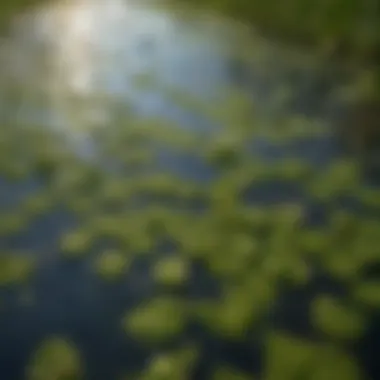
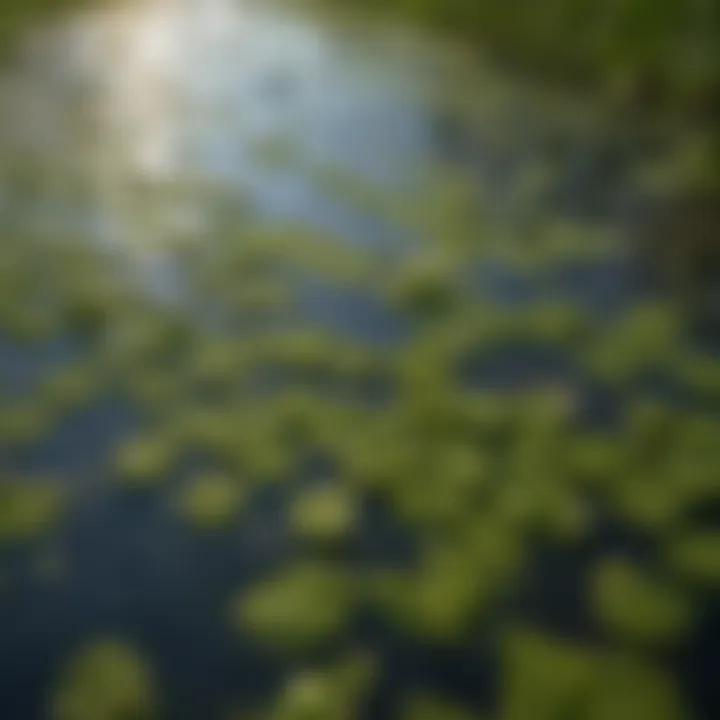
The Impact of Duckweed on Aquatic Ecosystems
Duckweed, that tiny green floating plant, often gets a bad rap in aquatic systems. However, its role is not simply a nuisance. Understanding the impact of duckweed on aquatic ecosystems is crucial for both conservationists and environmentalists. It’s like the unsung hero in a story where the hero always seems to hang back in the shadows but plays a vital role nonetheless.
When ecosystems are examined, one quickly sees that duckweed can influence several aspects of water quality, biodiversity, and even broader ecological functions. It’s a double-edged sword, creating a delicate balance that can tip either way, depending on various environmental factors.
Duckweed’s Effect on Water Quality
Duckweed can significantly affect water quality in various ponds and lakes. While they are known for rapid growth, their presence also means they are great at filtering pollutants.
- Nutrient Absorption: Duckweed absorbs nutrients like nitrogen and phosphorus, acting as a natural filter, which can lead to clearer water. This absorption can help mitigate the effects of nutrient pollution, a pressing concern for many aquatic environments.
- Oxygen Levels: However, dense mats can impede oxygen transfer within water columns.
- When duckweed blooms uncontrollably, it may block sunlight, preventing submerged plants from thriving. This subsequently leads to oxygen depletion, impacting fish and other aquatic organisms.
- The rapid decay of these plants can further reduce oxygen levels, creating dangerous conditions for aquatic life.
While duckweed can serve as a bio-indicator of water quality, it’s important to monitor its growth to ensure that it does not tip from beneficial to detrimental.
Duckweed and Biodiversity
The relationship between duckweed and biodiversity is yet another facet of its ecological role. This plant provides a unique habitat that can both support and threaten aquatic species.
- Supporting Roles: Duckweed offers shelter and breeding grounds for certain species of fish and invertebrates. Many small organisms benefit from the cover it provides, which can protect them from predators. This relationship enhances food webs within the ecosystem.
- Competition and Displacement: On the flip side, duckweed can compete aggressively with other aquatic plants for light and nutrients. This competition can potentially lead to a decrease in plant diversity, creating a less resilient ecosystem overall.
- Loss of biodiversity can disturb food chains, impacting larger species reliant upon a variety of smaller organisms for sustenance.
Potential Benefits of Duckweed
Despite its complex role, there are tangible benefits to duckweed that conservationists should note.
- Lignin Resource: Duckweed can be harvested and used in agriculture as a high-protein feed for livestock. It may help in reducing the reliance on commercial feeds, promoting sustainable practices.
- Bioenergy Potential: This floating plant holds promise for the bioenergy sector, too. Its fast growth cycle makes it an ideal candidate for biofuel production.
- Additionally, local economies can benefit from the sale of duckweed as an organic fertilizer, enriched with nutrients.
"Harnessing the power of duckweed for positive outcomes in sustainability can turn its reputation around from nuisance to ally."
- Educational Opportunities: With growing interest in environmental science and conservation, duckweed can serve as an engaging subject for both education and research. It opens pathways for hands-on learning experiences about ecosystems and biodynamics.
Understanding duckweed's multifaceted impacts enables better management of aquatic resources. Catching the glimpse of a single leaf might reveal a larger narrative that integrates conservation efforts, ecological health, and sustainable practices. In the end, it’s about navigating the complexities of our ecosystems thoughtfully.
Challenges of Duckweed Control
When it comes to managing duckweed, understanding the challenges involved is as crucial as the strategies for removal. Duckweed is not just an ordinary aquatic plant; its ability to reproduce rapidly and thrive under various conditions makes it a formidable weed in ponds and lakes. For conservationists, students, and environmentalists, grasping these challenges sheds light on why proactive measures are necessary. The thin line between maintaining ecosystem balance and letting duckweed take over is often blurred by these persistent challenges.
Understanding Rapid Reproduction
Duckweed is known for its uncanny knack for multiplying. Under optimal conditions, it can double its biomass in as little as two days. This rapid reproduction presents a daunting obstacle for anyone trying to control its spread. The plant employs a form of vegetative reproduction, where new plants sprout from existing ones. This method means that even minor infestations can snowball, turning a small patch of duckweed into a dense mat of green in no time.
Factors such as warm weather, ample sunlight, and nutrient-rich waters significantly accelerate this process. In fact, one could say that the conditions that promote aquatic life can also act as a double-edged sword when it comes to managing duckweed.
"Duckweed's rapid reproduction is less like a growth spurt and more like a green tidal wave."
As a result, controlling duckweed becomes not just about removal, but also about managing environmental factors that contribute to its rapid growth. Ignoring the underlying conditions can lead to a recurring battle, making it seem like one is painting over rust rather than addressing the root of the problem.
Identifying Contributing Factors to Growth
The prevalence of duckweed is intricately linked to various environmental factors that can create a perfect storm for its growth. Some of these factors warrant further examination:
- Nutrient Levels: High levels of nitrogen and phosphorus, often results from runoff or over-fertilization, significantly contribute to duckweed's growth. When nutrient levels spike, duckweed gets the fuel it needs to thrive.
- Sunlight: Duckweed loves sunlight; it thrives in clear waters where sunlight penetrates deeply. This means that shaded areas of the water body tend to remain free of duckweed, offering a direct connection between light availability and growth.
- Water Temperature: Warm waters generally favor duckweed's growth. Therefore, in warmer climates or during hot summer months, duckweed may flourish, while cooler temperatures tend to inhibit its expansion.
- Stability of Water Levels: Fluctuating water levels can either help or hinder duckweed populations. When water levels are stable, it fosters ideal conditions for duckweed to spread, but sudden drops or rises can disrupt its growth patterns.
These contributing factors highlight the complexity of duckweed management. It's essential to monitor not only the duckweed population but also the entire ecosystem to develop effective control techniques. Without a nuanced understanding of the ingredients that lead to the duckweed explosion, any control efforts could be akin to putting out a fire with gasoline.
Natural Methods to Control Duckweed
Controlling duckweed in aquatic environments calls for a careful examination of natural methods, which have gained traction over the years. These strategies not only provide a pathway to manage this persistent plant without harmful chemicals but they also align with eco-friendly practices. Emphasizing natural control allows for sustainable interactions with the ecosystem, ultimately leading to healthier aquatic environments. The inclusion of these methods could also reduce reliance on synthetic solutions, which can be harmful to aquatic life.
Manual Removal Techniques
Effective Use of Netting
Using netting presents a straightforward yet effective way to address duckweed issues. This method involves strategically placing nets over areas infested with duckweed, allowing for easy collection and removal. The key characteristic of this technique lies in its simplicity. Anyone can implement it without specialized training, making it both a practical and beneficial choice for small pond owners and larger aquatic managers alike.
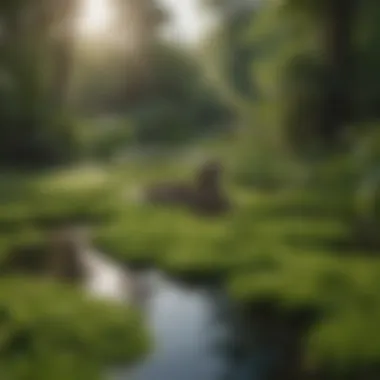

For instance, when deployed properly, nets can capture thick mats of duckweed without disturbing the underlying water body. However, it does require consistent monitoring and labor, which can be viewed as a disadvantage, especially for larger areas. On the plus side, it minimizes potential harm to other aquatic organisms, ensuring that any beneficial species remain unharmed.
Hand-Picking Best Practices
Hand-picking is the most straightforward method, requiring minimal tools and a bit of patience. This method involves physically removing duckweed plants from the water's surface. Hand-picking is essential in small ponds where duckweed hasn’t completely taken over, and specific areas need focused attention.
The key here is the personal attention it brings. It allows for quick assessment of the infestation's severity while selectively removing unwanted plants. Yet, the main advantage is also a drawback: it can be labor-intensive. For those dedicated to their local ecosystems, the effort can lead to a satisfying outcome as they witness the gradual transformation of their aquatic environments.
Use of Natural Predators
Introducing Fish Species
Introducing fish species that feed on duckweed is a time-honored method embraced by many. Species like Goldfish and Tilapia are known to help in controlling twofold, by eating duckweed and contributing to the ecosystem's diversity. The attractiveness of using fish lies in their natural behavior; they integrate seamlessly into the aquatic environment, providing a sustainable control measure.
However, careful consideration is necessary. Not all fish can coexist harmoniously with existing wildlife, and their introduction could disrupt the ecosystem balance. Moreover, they may not completely eradicate duckweed, serving only as a temporary measure. Overall, this natural strategy can enhance biological diversity while managing a challenging plant.
Employing Invertebrate Predators
Another strategy is through employing invertebrate predators such as certain types of snails and water beetles. These organisms contribute positively by feeding on duckweed and aiding in its control. The unique feature of invertebrate predators lies in their efficiency; they don't require any special care compared to fish. This makes them an appealing option for those looking to maintain a self-sustaining environment.
Nevertheless, potential downsides exist. Invertebrates might not be as effective in large-scale infestations, and certain types could target beneficial aquatic plants as well. Proper research on the specific invertebrate species is key to minimizing unintended consequences.
Cultivating Competition
Planting Beneficial Aquatic Plants
Cultivating competition among plants can significantly reduce duckweed dominance in an aquatic habitat. By introducing or enhancing the growth of beneficial aquatic plants, such as Hornwort or Water Lilies, one can create a more balanced ecosystem. These plants compete for nutrients and space, thereby limiting duckweed’s growth potential and establishing a healthier aquatic environment.
The key characteristic of this method is its ability to foster biodiversity while reducing reliance on mechanical removal. However, introducing new species requires careful consideration as they must be compatible with existing flora and fauna. If managed well, this becomes a sustainable solution that continuously adapts to the environment.
Creating Diverse Ecosystems
Lastly, establishing diverse ecosystems proves vital in controlling duckweed growth effectively. By creating a balance of different plant and animal species, the overall ecosystem health improves, allowing for natural regulation of all species. A diverse habitat attracts a variety of wildlife, which can help with pest control naturally, including duckweed.
One distinct feature of this method lies in its long-term benefits. Over time, a rich variety of organisms working together leads to a stable and resilient environment. The downside, once again, is the time investment required to establish such an ecosystem. It calls for patience and knowledge, but it ultimately pays off in maintaining a duckweed-free pond over the years.
Altering Environmental Conditions
Altering environmental conditions is a vital strategy when it comes to managing duckweed populations. This approach can significantly affect the growth cycles of this aquatic plant by changing the conditions it thrives in. Here, we break down two critical factors: nutrient levels and light exposure, both of which play a fundamental role in the overall dynamics of duckweed in aquatic systems.
Managing Nutrient Levels
Addressing Over-Nutrification
Over-nutrification occurs when excess nutrients, particularly nitrogen and phosphorus, enter water bodies. This phenomenon largely stems from agricultural runoff, improper waste disposal, and over-fertilization practices. Duckweed, being a nutrient-loving plant, flourishes in these environments, leading to their unchecked proliferation. Addressing over-nutrification becomes paramount to mitigate this issue.
By reducing nutrient inputs through various methods, such as redirecting runoff or utilizing permeable materials that allow for filtration, we can significantly decrease the potential growth of duckweed.
One key characteristic of addressing over-nutrification is its controllability. Farmers and communities can adopt sustainable practices, like planting buffer zones or implementing natural waste recycling techniques, to lessen nutrient overload. However, the challenge lies in the initial investment and community agreement on practices, which might not yield instant results but will contribute to a healthier aquatic ecosystem over time.
Implementing Natural Filtration
Natural filtration is another excellent method to manage nutrient levels. Techniques such as creating wetlands or employing aquatic plants that absorb excess nutrients can keep the water in our lakes and ponds cleaner and healthier. This method not only helps in filtering out harmful substances but also enhances the habitat for various aquatic life forms, creating a balanced ecosystem.
The beauty of natural filtration lies in its dual benefit. Not only does it mitigate the nutrient levels that favor duckweed growth, it also supports biodiversity. However, its effectiveness hinges on proper planning and regular monitoring. Implementing natural filtration systems can be an ongoing effort as the filtration capacity relies on environmental conditions and the specific plants used.
Controlling Light Exposure
Utilizing Shade Techniques
Shade techniques involve creating shadow over water surfaces to restrict sunlight, which in turn inhibits duckweed development. Common methods include placing structures like floating islands or strategically planting taller vegetation around pond edges. The key characteristic here is the ability to control the environment without drastic chemical interventions.
By utilizing shade, we can lessen photosynthesis rates among duckweed, slowing down its spread considerably. Additionally, shade techniques are aesthetically pleasing and can enhance the visual appeal of outdoor spaces. The downside, however, is that excessive shading may inadvertently harm other beneficial aquatic plants that require sunlight.
Manipulating Water Surface Coverage
Manipulating water surface coverage involves altering the water's top layer through various means, like introducing competitive plant species or using products like floating mats. This acts as a barrier to prevent sunlight from penetrating deeper waters where duckweed thrives. The primary advantage of this approach is that it can be a proactive method of keeping duckweed in check, while also promoting the growth of desirable species.
Ultimately, managing water surface coverage needs a balanced approach, as too many barriers can disrupt local aquatic ecosystems, making it critical to monitor the specific conditions and needs of the habitat. Through a combination of these techniques, we can create a more sustainable and balanced aquatic environment, reducing the chances of duckweed re-establishing itself.
"Prevention is better than cure; understanding the conditions that favor duckweed is crucial in eradicating it effectively."
By strategically managing nutrient levels and controlling light exposure, we set the stage for diminishing duckweed presence. Each method carries weight in what it contributes to overall health of aquatic ecosystems.
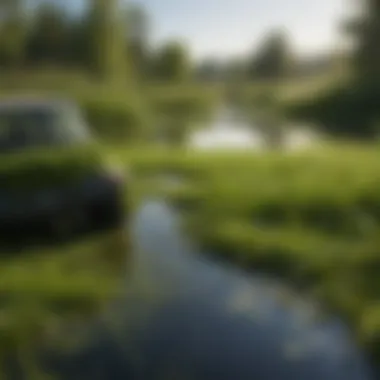
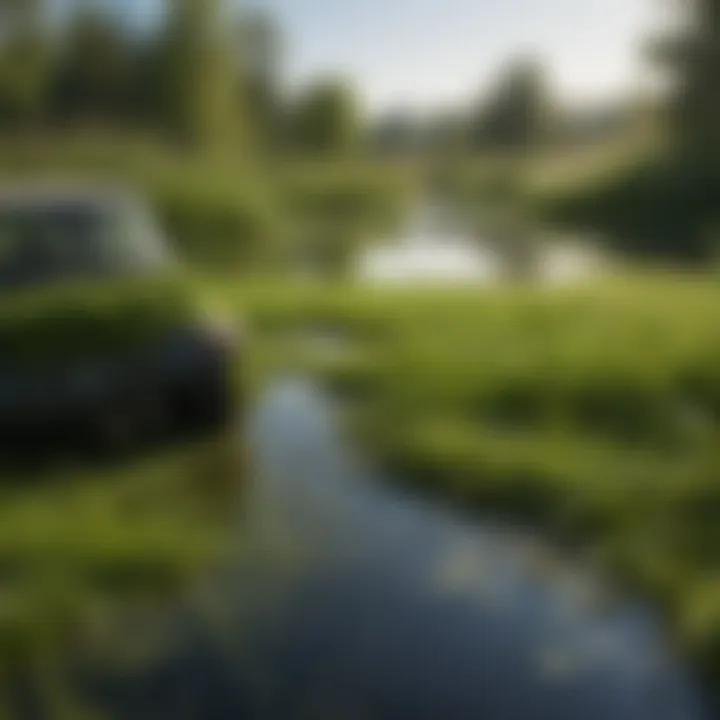
Preventive Strategies for Future Control
Preventive strategies are crucial in managing duckweed, ensuring its growth does not spiral out of control. A proactive approach can save time, effort, and potential ecological damage down the line. By implementing regular maintenance and fostering community education, individuals and organizations can establish an environment that discourages the unchecked proliferation of this aquatic plant.
Regular Maintenance Practices
Regular maintenance practices play a significant role in preventing duckweed from becoming a nuisance in ponds and lakes. Consistent monitoring and management can effectively keep this plant in check, giving other aquatic species the opportunity to thrive. Several key methods stand out.
Monitoring Water Levels
Monitoring water levels is a fundamental practice when dealing with aquatic environments regulated by different factors, including evaporation, precipitation, and any surrounding landscapes. By watching these levels, one can establish whether there’s an overabundance of nutrients that can fuel duckweed's rapid growth. The distinctive feature of this practice is that it empowers caretakers to react promptly to changes rather than waiting for a larger problem to develop.
Having a consistent eye on water levels is especially effective because it allows the detecting of fluctuations that lead to increased growth rates of duckweed. This can act as an early warning signal, indicating when action is necessary. However, relying solely on this method may not always offer a complete solution, as external factors can influence water levels unexpectedly.
Aquatic Plant Management
Aquatic plant management is another significant preventative measure against duckweed. This strategy involves carefully selecting and allowing the growth of other aquatic plants that compete with duckweed for resources. Not only does this approach help in curbing duckweed's spread, but it also promotes a balanced ecosystem, bringing benefits like improved oxygen levels and enhanced water quality.
The key characteristic of this method is its focus on diversity, which can make aquatic habitats less hospitable to duckweed. Growing certain species can naturally limit space and resource availability for duckweed, making it a very beneficial tactic. Nonetheless, it requires an understanding of local ecosystems, which means there's a risk if unsuitable plants are introduced, possibly creating further issues.
Education and Awareness
Communities equipped with knowledge about duckweed and its management can better tackle this persistent plant. Educating people and creating awareness will enable community-driven efforts to reduce duckweed growth over time. The value of education can not be overstated.
Community Involvement
Community involvement is an effective way to monitor and maintain aquatic spaces. Engaging local residents fosters a sense of responsibility and collective action, leading to significant ecological benefits. By organizing clean-up events, community workshops, or shared responsibilities for regular monitoring, a community enforced framework can deter duckweed expansion.
A unique feature of this involvement is that it builds social connections while tackling environmental issues simultaneously. Still, it can be a mixed bag, as participation levels may fluctuate, and dedication can vary among members.
Sharing Best Practices
Sharing best practices across the community provides a foundational tool for collective success. Establishing communication platforms, whether online or in-person, cultivates an exchange of ideas and experiences in managing duckweed. This aspect fosters collaboration, helping individual efforts to be more impactful.
The distinctive trait of this strategy is its ability to adapt and grow through the constant sharing of new findings. Communities can benefit from previous successes or mistakes noted by others, but the challenge lies in ensuring the consistency of knowledge transfer. All community members must feel empowered to share insights, as lapses can lead to gaps in overall strategy effectiveness.
"Through community education and regular maintenance, we can take significant steps in preventing the spread of duckweed, ensuring aquatic ecosystems flourish."
As we can see, preventive strategies forge a pathway towards sustainable management of duckweed and the health of the broader aquatic ecosystem.
Evaluating the Effectiveness of Control Methods
Evaluating the effectiveness of control methods is a pivotal element in managing duckweed. It's not just about killing the plant; it’s about determining what works best in specific conditions and ensuring that the ecosystem remains balanced. When we assess various strategies, we can discern the impact on both duckweed populations and the broader aquatic environment. Knowing what’s effective can guide conservationists in selecting the right approach while minimizing adverse effects, making it a win-win.
Monitoring Duckweed Population Trends
Keeping a close eye on duckweed population trends is essential for evaluating control methods. At first glance, it might seem tedious to track tiny green leaves, but this monitoring unveils vital insights. Regular population counts allow for the identification of growth patterns, revealing the effectiveness of various control measures over time.
- Identify Seasonal Changes: Duckweed’s growth can be influenced by seasons, which means monitoring can unveil cyclical patterns. For instance, populations might surge in spring, prompting targeted control just before peak growth.
- Assess Control Methods' Impact: After implementing a management strategy, like introducing natural predators or adjusting nutrient levels, it's important to see whether those approaches are reducing duckweed effectively. A noticeable decline in coverage indicates success and may influence future strategies used.
- Implement Data Logging: Keeping logs—be it on paper or digital—helps track when interventions were made and what results were noted. This data can lead to sophisticated analysis, meaning better-informed decisions in the future.
Assessing Ecosystem Health Post-Control
Once duckweed control measures are employed, it's crucial to assess the overall health of the ecosystem. This involves scrutinizing not only the state of duckweed but also the entire aquatic community. Here are key elements to consider:
- Biodiversity Recovery: After duckweed is managed, evaluating how other species respond is essential. An increase in native aquatic plants and animals signifies a healthier ecosystem. Diversity usually strengthens resilience against environmental stressors.
- Water Quality Analysis: It’s also wise to test the water quality following control methods. Since duckweed affects nutrient cycling and oxygen levels, checking parameters like turbidity, dissolved oxygen, and pH can provide insights into the recovery of the water body.
- Long-Term Monitoring: Implementing a continued assessment plan can help gauge whether the initial control efforts truly led to sustained ecological balance. Monitoring not just at peak times but year-round can illuminate unexpected consequences or improvements in the aquatic system, ensuring ongoing health.
"A careful evaluation of both duckweed populations and the ecosystem is key to informed management. Without these insights, any effort could be a shot in the dark."
Ending: Sustainable Approaches to Duckweed Management
Managing duckweed in aquatic environments requires a nuanced understanding of both the plant and the ecosystem it inhabits. As discussed throughout this guide, it’s critical to approach duckweed control not as an isolated task but as part of a broader strategy that encompasses sustainable practices. Given the potential for duckweed to impact water quality and biodiversity, the significance of finding sustainable eradication methods cannot be overstated. The delicate balance of aquatic ecosystems can easily be disrupted by the rapid growth of duckweed, but through careful planning and concerted efforts, it’s possible to mitigate its spread effectively.
Integrating Various Methods for Best Results
To successfully manage duckweed, employing a combination of strategies is often more effective than relying on a single method. This is where a multi-faceted approach comes into play:
- Manual Removal: Utilizing techniques like netting or hand-picking can help in immediate situations of overgrowth, especially in smaller ponds or water bodies.
- Natural Predators: Introducing species such as goldfish or certain snails can provide a biological counterbalance against the proliferation of duckweed. These predators consume the plant, reducing its biomass while supporting the local ecosystem.
- Environmental Management: Adjusting nutrient levels by reducing fertilizer runoff and controlling light exposure can create less conducive conditions for duckweed growth. By integrating shade techniques and diversifying plant life, one can promote a healthier aquatic habitat.
By combining these methods, individuals can address the problem from multiple angles. This holistic approach tends to yield better results because it not only targets duckweed specifically, but also enhances the overall health of the aquatic ecosystem. As the old saying goes, "Don’t put all your eggs in one basket." In this case, varying your approach ensures you have backups and a sustainable way to keep your aquatic environments thriving.
The Importance of Long-Term Monitoring
This brings us to long-term monitoring, an essential component of duckweed management that often gets overlooked. Regularly observing the conditions of the water body and the effects of implemented strategies are crucial:
- Tracking Duckweed Populations: Being diligent in monitoring allows you to identify trends over time. If duckweed numbers are fluctuating despite control efforts, this can signal a need for adjustments in your strategy.
- Assessing Ecosystem Health: Monitoring ecosystem health after control methods are put in place is vital. It helps gauge whether the environment is recovering and diversifying, or if new issues are arising. If the ecosystem starts to degrade, you have a real-time view of which strategies are falling short.
- Adaptability: Environmental conditions and biological interactions change over time. Regular checks help you stay adaptable; if one method starts to fail, being informed allows you to pivot to another. A proactive approach can prevent small problems from becoming larger, more complicated issues.
Ultimately, sustainable approaches to duckweed management rest upon integration and monitoring. Balancing various methods while keeping a close eye on the ecosystem’s health is key. It’s about more than just controlling a pesky plant; it’s about fostering vibrant, healthy aquatic environments that can support a diverse range of life. Educating oneself about the ecosystem and staying engaged with community and conservation efforts are equally critical for long-term success. As simplifying complexities stands at the heart of sustainability, managing duckweed with foresight helps ensure that our aquatic ecosystems continue to flourish for years to come.



